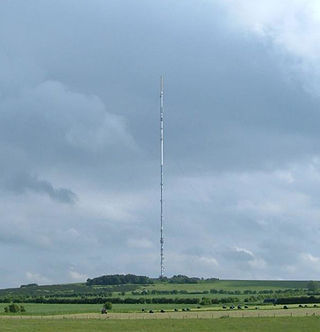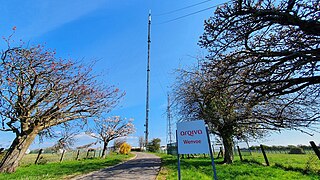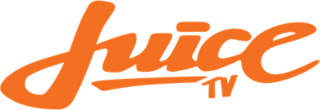Related Research Articles

Terrestrial television or over-the-air television (OTA) is a type of television broadcasting in which the content is transmitted via radio waves from the terrestrial (Earth-based) transmitter of a TV station to a TV receiver having an antenna. The term terrestrial is more common in Europe and Latin America, while in Canada and the United States it is called over-the-air or simply broadcast. This type of TV broadcast is distinguished from newer technologies, such as satellite television, in which the signal is transmitted to the receiver from an overhead satellite; cable television, in which the signal is carried to the receiver through a cable; and Internet Protocol television, in which the signal is received over an Internet stream or on a network utilizing the Internet Protocol. Terrestrial television stations broadcast on television channels with frequencies between about 52 and 600 MHz in the VHF and UHF bands. Since radio waves in these bands travel by line of sight, reception is generally limited by the visual horizon to distances of 64–97 kilometres (40–60 mi), although under better conditions and with tropospheric ducting, signals can sometimes be received hundreds of kilometers distant.

Television in New Zealand was introduced in 1960 as a state-run service. The broadcasting sector was deregulated in 1989, when the Government allowed competition to the state-owned Television New Zealand (TVNZ). There are currently three forms of broadcast television: a terrestrial (DVB-T) service provided by Freeview; as well as satellite (DVB-S) and internet streaming (IPTV) services provided nationwide by both Freeview and Sky.

Television New Zealand, more commonly referred to as TVNZ, is a television network that is broadcast throughout New Zealand and parts of the Pacific region. All of its currently-operating channels are free-to-air and commercially funded.

Sky Network Television Limited, more commonly known as Sky, is a New Zealand broadcasting company that provides pay television services via satellite, media streaming services, and broadband internet services. As of 31 December 2022, Sky had 1,023,378 residential television subscribers consisting of 517,003 satellite subscribers and 506,375 streaming subscribers. Additionally, Sky had 23,156 broadband customers. Despite the similarity of name, branding and services, such as Sky Go and MySky shared with its European equivalent, Sky Group, there is no connection between the companies.
Three, stylized as +HR=E, is a New Zealand nationwide television channel. Launched on 26 November 1989 as TV3, it was New Zealand's first privately owned television channel. The channel currently broadcasts nationally in digital free-to-air form via the state-owned Kordia on terrestrial and satellite. Vodafone also carries the channel for their cable subscribers in Wellington and Christchurch. It previously broadcast nationally on analogue television until that was switched off on 1 December 2013.
102.9 Triple M Newcastle is an Australian radio station, licensed to, and serving Newcastle and surrounds. It broadcasts at 102.9 megahertz on the FM band from its studios in Newcastle. It is owned by Southern Cross Austereo.

The Mendip transmitting station is a broadcasting and telecommunications facility on the summit of Pen Hill, part of the Mendip Hills range in Somerset, England, at 305 metres (1,001 ft) above sea level. The station is in St Cuthbert Out civil parish, approximately 2 miles (3.2 km) north-east of Wells. Its mast, 293 m (961 ft) high, was built in 1967 and is the tallest structure in South West England. The mast broadcasts digital television, FM analogue radio and DAB digital radio, and had broadcast analogue colour television from 1967 until 2010.

The Moel-y-Parc transmitting station is situated on Moel y Parc, a hill in north-east Wales at the northern end of the Clwydian range, close to the town of Caerwys and several miles (kilometres) north-east of Denbigh. It was built in 1962/1963 by the IBA to bring 405-line VHF ITV television to North Wales and it has been on the air since 1963. Its original height of 229 metres (751 ft) made it the tallest structure in North Wales and it stands on land that is itself about 335 metres (1,099 ft) above sea level. In 1965, VHF television transmissions from the BBC commenced from the site.

The Wenvoe transmitting station, officially known as Arqiva Wenvoe, is the main facility for broadcasting and telecommunications for South Wales and the West Country. It is situated close to the village of Wenvoe in the Vale of Glamorgan, Wales, in the UK.

Juice TV, is a 24-hour music television channel operating from the Auckland suburb of Parnell in New Zealand. The channel is available on channel 38 on the Freeview streaming app. It also broadcasts 18 hours a day on CH200, Kordia's local channel on Freeview terrestrial.

TVNZ 1 is the first national television channel owned and operated by the state-owned broadcaster Television New Zealand (TVNZ). It is the oldest television broadcaster in New Zealand, starting out from 1960 as independent channels in the four main centres of Auckland, Wellington, Christchurch and Dunedin, networking in 1969 to become NZBC TV. The network was renamed Television One in 1975 upon the break-up of the New Zealand Broadcasting Corporation, and became a part of TVNZ in 1980 when Television One and South Pacific Television merged. The channel assumed its current name in October 2016.

Education Channel TV4 formerly "Government Information Services Limited", "The National Carnival Commission of Trinidad and Tobago" (NCC4), "The Information Channel" (TIC) and "AVM Television", is a television station serving Trinidad and Tobago on Channels 4 & 16 with its studios located at TIC Building, Lady Young Road, Morvant, Trinidad and Tobago.
Freeview is New Zealand's free-to-air television platform. It is operated by a joint venture between the country's major free-to-air broadcasters – government-owned Television New Zealand and Radio New Zealand, government-subsidised Whakaata Māori, and the American-owned Warner Bros. Discovery.
The Oxford transmitting station is a broadcasting and telecommunications facility, situated on land 129.5 metres (425 ft) above Ordnance Datum to the north east of the city of Oxford, in Oxfordshire, England. It has a guyed steel lattice mast which is 154.4 metres (507 ft) in height to the top of the main steel structure. The UHF television antenna, which consist of a vertical array of transmitting panels, is mounted above the steel structure. The total height of the mast to the top of this UHF antenna is 165.7 metres (544 ft). It is owned and operated by Arqiva.
Television frequency allocation has evolved since the start of television in Australia in 1956, and later in New Zealand in 1960. There was no coordination between the national spectrum management authorities in either country to establish the frequency allocations. The management of the spectrum in both countries is largely the product of their economical and political situation. New Zealand didn't start to develop television service until 1965 due to World War 2 and its economic harm in the country's economy.

Sky Multichannels was a package of analogue television services offered by BSkyB on the Astra satellites at 19.2° east from 1 September 1993 to 27 September 2001, which started off with 15 channels before expanding to over 40.

Sandy Heath transmitting station is a television and radio broadcasting station in England, located between Sandy, Bedfordshire and Potton near the B1042. It is owned by Arqiva, formerly NTL Broadcast. It was built in 1965, originally broadcasting Anglia Television on VHF 405-lines, UHF with 625-line services of BBC2, BBC1, and Anglia Television being added by January 1971. It carried Channel 4 and Channel 5 from their launch days, Channel 5 at lower power than the other four services. Today it broadcasts digital television on the DTT platform as digital switchover took place on 13 April 2011. On 17 June 2018, as part of the 700MHz clearance, Com5 moved from Ch52 to Ch36, Com7 moved from Ch32 to Ch55 and Com8 moved from Ch34 to Ch56

Cape Town TV is a community television channel that broadcasts in Cape Town, South Africa. It launched in September 2008 with a one-year, "temporary" license and thereafter won another such license in September 2009. It is a non-profit organisation that is licensed as a community broadcaster in terms of South Africa's Electronic Communications Act.
Home Video Channel (HVC) was a British cable television channel that began operating in 1985, broadcasting low-budget films between 8:00 p.m. and midnight. Film genres included horror, action, adventure, science fiction, and erotica. In 1992, a second channel, The Adult Channel, was launched by HVC's owner, Home Video Channel Limited (HVCL). It broadcast erotic films and softcore pornography.
Shine TV is a New Zealand Christian television channel operated by Rhema Media and broadcast on Freeview Channel 25 and Sky TV channel 201. The station promotes Christian lifestyles, traditional Christian values, Gospel teachings and interdenominational Christian unity. From its outset, it has focused primarily on children, young people and family audiences.
References
- 1 2 3 4 Bertram, Gavin (18 July 2014). "Max TV - Not given lightly". Audio Culture . Retrieved 8 March 2018.
- ↑ "Listener". 15 January 1994
- ↑ Maling, S.R. (4 September 1997). "Women Against Pornography (Auckland) (WAP) and Max TV Ltd - 1997-115". Broadcasting Standards Authority . Retrieved 8 March 2018.